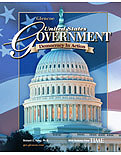
U. S. Government: Democracy In ActionChapter 12: Supreme Court Decision MakingChapter OverviewsThe Supreme Court is the highest court in the land. Hearing cases from prisoners to presidents, the Supreme Court has the final ruling in all cases involving federal law. Chapter 12 deals with the operations of the Supreme Court including the shaping of public policy and how the Court selects, hears, and decides cases. Section 1 introduces terms such as writ of certiorari, per curiam opinion, brief, amicus curiae, majority opinion, and dissenting opinion to illustrate how the Supreme Court handles cases. More cases are appealed to the Court than the justices have time to see. Therefore, the justices choose the cases they hear based on the constitutional issues these cases raise. Section 2 explains how decisions made by the Supreme Court influence public policy. The Supreme Court is considered to be both a legal and a political institution because of the effect its decisions have on public policy. When the Court makes a decision about a piece of legislation, it is determining public policy. Section 3 deals with the influences felt by the Court when making decisions. Supreme Court justices must contend with influences such as their personal views, social forces, and public attitudes. Since the Court only hears cases that affect an important constitutional issue, the justices must try to base their decisions on the principles of law and not on outside influences. |  |















